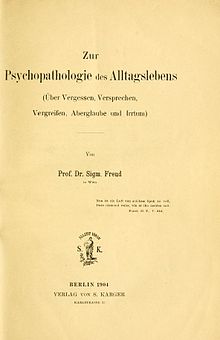Related Research Articles

Jacques Marie Émile Lacan was a French psychoanalyst and psychiatrist. Described as "the most controversial psycho-analyst since Freud", Lacan gave yearly seminars in Paris, from 1953 to 1981, and published papers that were later collected in the book Écrits. Transcriptions of his seminars, given between 1954 and 1976, were also published. His work made a significant impact on continental philosophy and cultural theory in areas such as post-structuralism, critical theory, feminist theory and film theory, as well as on the practice of psychoanalysis itself.
Psychoanalysis is a set of theories and therapeutic techniques that deal in part with the unconscious mind, and which together form a method of treatment for mental disorders. The discipline was established in the early 1890s by Sigmund Freud, whose work stemmed partly from the clinical work of Josef Breuer and others. Freud developed and refined the theory and practice of psychoanalysis until his death in 1939. In an encyclopedic article, he identified the cornerstones of psychoanalysis as "the assumption that there are unconscious mental processes, the recognition of the theory of repression and resistance, the appreciation of the importance of sexuality and of the Oedipus complex." Freud's colleagues Alfred Adler and Carl Gustav Jung developed offshoots of psychoanalysis which they called individual psychology (Adler) and analytical psychology (Jung), although Freud himself wrote a number of criticisms of them and emphatically denied that they were forms of psychoanalysis. Psychoanalysis was later developed in different directions by neo-Freudian thinkers, such as Erich Fromm, Karen Horney, and Harry Stack Sullivan.

Sigmund Freud was an Austrian neurologist and the founder of psychoanalysis, a clinical method for evaluating and treating pathologies seen as originating from conflicts in the psyche, through dialogue between patient and psychoanalyst, and the distinctive theory of mind and human agency derived from it.
In psychoanalysis and other psychological theories, the unconscious mind is the part of the psyche that is not available to introspection. Although these processes exist beneath the surface of conscious awareness, they are thought to exert an effect on conscious thought processes and behavior. Empirical evidence suggests that unconscious phenomena include repressed feelings and desires, memories, automatic skills, subliminal perceptions, and automatic reactions. The term was coined by the 18th-century German Romantic philosopher Friedrich Schelling and later introduced into English by the poet and essayist Samuel Taylor Coleridge.
Psychoanalytic literary criticism is literary criticism or literary theory that, in method, concept, or form, is influenced by the tradition of psychoanalysis begun by Sigmund Freud.
Psychoanalytic theory is the theory of personality organization and the dynamics of personality development relating to the practice of psychoanalysis, a clinical method for treating psychopathology. First laid out by Sigmund Freud in the late 19th century, psychoanalytic theory has undergone many refinements since his work. The psychoanalytic theory came to full prominence in the last third of the twentieth century as part of the flow of critical discourse regarding psychological treatments after the 1960s, long after Freud's death in 1939. Freud had ceased his analysis of the brain and his physiological studies and shifted his focus to the study of the psyche, and on treatment using free association and the phenomena of transference. His study emphasized the recognition of childhood events that could influence the mental functioning of adults. His examination of the genetic and then the developmental aspects gave the psychoanalytic theory its characteristics.
In psychoanalysis, a Freudian slip, also called parapraxis, is an error in speech, memory, or physical action that occurs due to the interference of an unconscious subdued wish or internal train of thought. Classical examples involve slips of the tongue, but psychoanalytic theory also embraces misreadings, mishearings, mistypings, temporary forgettings, and the mislaying and losing of objects.
A complex is a structure in the unconscious that is objectified as an underlying theme—like a power or a status—by grouping clusters of emotions, memories, perceptions and wishes in response to a threat to the stability of the self. In psychoanalysis, it is antithetical to drives.
Repression is a key concept of psychoanalysis, where it is understood as a defense mechanism that "ensures that what is unacceptable to the conscious mind, and would if recalled arouse anxiety, is prevented from entering into it." According to psychoanalytic theory, repression plays a major role in many mental illnesses, and in the psyche of the average person.
A speech error, commonly referred to as a slip of the tongue or misspeaking, is a deviation from the apparently intended form of an utterance. They can be subdivided into spontaneously and inadvertently produced speech errors and intentionally produced word-plays or puns. Another distinction can be drawn between production and comprehension errors. Errors in speech production and perception are also called performance errors. Some examples of speech error include sound exchange or sound anticipation errors. In sound exchange errors, the order of two individual morphemes is reversed, while in sound anticipation errors a sound from a later syllable replaces one from an earlier syllable. Slips of the tongue are a normal and common occurrence. One study shows that most people can make up to as much as 22 slips of the tongue per day.

Sebastiano Timpanaro was an Italian classical philologist, essayist, and literary critic. He was also a long-time Marxist who made important contributions to left-wing political causes. He was an atheist.
The Symbolic is the order in the unconscious that gives rise to subjectivity and bridges intersubjectivity between two subjects; an example is Jacques Lacan's idea of desire as the desire of the Other, maintained by the Symbolic's subjectification of the Other into speech. In the later psychoanalytic theory of Lacan, it is linked by the sinthome to the Imaginary and the Real.

The Four Fundamental Concepts of Psychoanalysis is the 1978 English-language translation of a seminar held by Jacques Lacan. The original was published in Paris by Le Seuil in 1973. The Seminar was held at the École Normale Supérieure in Paris between January and June 1964 and is the eleventh in the series of The Seminar of Jacques Lacan. The text was published by Jacques-Alain Miller.
Otto Fenichel was a psychoanalyst of the so-called "second generation".

Psychopathology of Everyday Life is a 1901 work by Sigmund Freud, the founder of psychoanalysis. Based on Freud's researches into slips and parapraxes from 1897 onwards, it became perhaps the best-known of all Freud's writings.
Penis envy is a stage in Sigmund Freud's theory of female psychosexual development, in which young girls experience anxiety upon realization that they do not have a penis. Freud considered this realization a defining moment in a series of transitions toward a mature female sexuality. In Freudian theory, the penis envy stage begins the transition from attachment to the mother to competition with the mother for the attention and affection of the father. The young boy's realization that women do not have a penis is thought to result in castration anxiety.
The Signorelli parapraxis represents the first and best known example of a parapraxis and its analysis in Freud's The Psychopathology of Everyday Life. The parapraxis centers on a word-finding problem and the production of substitutes. Freud could not recall the name (Signorelli) of the painter of the Orvieto frescos and produced as substitutes the names of two painters Botticelli and Boltraffio. Freud's analysis shows what associative processes had linked Signorelli to Botticelli and Boltraffio. The analysis has been criticised by linguists and others.
In Freudian psychoanalysis, a condensation is when a single idea or dream object stands for several associations and ideas.
Lacanianism or Lacanian psychoanalysis is a theoretical system that explains the mind, behaviour, and culture through a structuralist and post-structuralist extension of classical psychoanalysis, initiated by the work of Jacques Lacan from the 1950s to the 1980s. Lacanian perspectives contend that the human mind is structured by the world of language, known as the Symbolic. They stress the importance of desire, which is conceived of as perpetual and impossible to satisfy. Contemporary Lacanianism is characterised by a broad range of thought and extensive debate between Lacanians.

Sigmund Freud is considered to be the founder of the psychodynamic approach to psychology, which looks to unconscious drives to explain human behavior. Freud believed that the mind is responsible for both conscious and unconscious decisions that it makes on the basis of psychological drives. The id, ego, and super-ego are three aspects of the mind Freud believed to comprise a person's personality. Freud believed people are "simply actors in the drama of [their] own minds, pushed by desire, pulled by coincidence. Underneath the surface, our personalities represent the power struggle going on deep within us".
References
- ↑ D. C. Greetham, Scholarly Editing (1995)p. 452
- ↑ S. Freud, Introductory Lectures on Psychoanalysis (PFL 1) p. 58
- ↑ Peter Gay, Freud: A Life for our Time (1989) p. 125
- ↑ D. C. Greetham, Theories of the Text (1999) p. 249-252
- ↑ Freud, quoted in A. Phillips, On Flirtation (1994) p. 12
- ↑ Jacques Lacan, Ecrits: A Selection (1997) p. 58
- ↑ Gay, p. 755
- ↑ Freud, p. 95
- ↑ B. A. Garner, Dictionary of Modern Legal Usage (1995) p. 499
- ↑ Freud, p. 58
- ↑ Greetham, Theories p. 246
- ↑ This is a different phenomenon from that described in the main article on haplologies, which involves the removal of identical consecutive syllables.
- ↑ Freud, p. 58-9
- ↑ B. M. Dupriez, Dictionary of Literary Devices (1991) p. 250
- ↑ Freud, p. 73
- ↑ P. Barrotta et al, Freud and Italian Culture (2009) p. 182
- ↑ Greetham, Theories p. 257-8
- ↑ Stanley Cavell, Little Did I Know (2010) p. 479